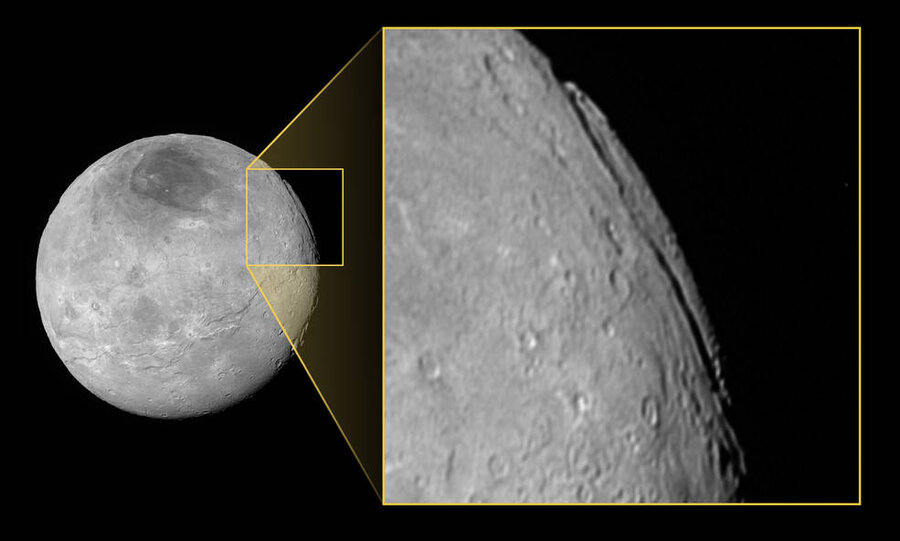New Horizon’s spacecraft spots humongous canyon on Pluto’s moon
Pluto’s largest moon, Charon, has a canyon that rivals not only Earth’s Grand Canyon, but every other canyon in the solar system.
NASA’s New Horizons spacecraft offered humanity its first detailed look at the icy worlds on the edge of the solar system when it sped past Pluto on July 14, 2015, with seven instruments collecting data that scientists will continue to receive until October.
The data sent back so far has already pointed to far more dynamic processes than scientists could have predicted shaping the dwarf planet and its moon over the past 4.5 billion years, which is exactly why the scientists launched the probe into the unknown.
"The fact that both Charon and Pluto turned out to be absolutely, over-the-top amazing tells us a lot about the importance of going off and exploring places that no one has ever seen before," Jeff Moore, research scientist and New Horizons Geology, Geophysics, and Imaging team leader, tells The Christian Science Monitor.
The latest New Horizons image reveals a canyon informally named Argo Chasma which appears to stretch 5.5 miles deep, more than five times the depth of the Grand Canyon, the space agency reports in Thursday's announcement. At several locations along the canyon's length, the sheer cliffs may rival those of Verona Rupes on Uranus's moon Miranda, the previous title-holder of the solar system's tallest cliff face.
The image displays 185 miles of Argo's total 430 mile predicted length. It's the second longest canyon system to be discovered on Charon, following a vast equatorial belt of chasms that run about 1,100 miles. For comparison, the Grand Canyon is roughly 280 miles long.
Dr. Moore has two explanations for Charon's canyon's potentially record-breaking depth.
"Probably the most important thing is that Charon has low gravity," Dr. Moore tells The Christian Science Monitor in a phone interview. "On a low gravity world like Charon where the gravity is less than one-twentieth the gravity of the Earth, then the walls can be very, very high." Secondly, the rate of impactors hitting the surface of Charon or Pluto is much lower than in the inner solar system, where we live, so there are fewer opportunities for them to come crashing into canyon walls, knocking them down.
"Low gravity and a low crater impact rate conspire to create a situation where the canyons can be as deep as they are," says Moore. The moons of Uranus and Saturn are about the same size as Charon, but because of the higher crater rates, the canyons and plains haven't been preserved as well. Studying Charon can therefore lead to a better understanding of those moons, too.
Very little was known about Charon before the New Horizon flyby, Alan Stern, principal investigator of the New Horizons mission says.
"About all we knew was its size, and its mass, and we knew its surface was composed primarily of water ice. And we knew that it was darker and less colorful than Pluto, but that’s really about it," Dr. Stern tells the Monitor.
The data beamed back to Earth by the New Horizons space probe has revealed an unexpected amount of activity on the moon, with evidence of tectonics, glacial flow, and possible cryovolcanoes, as New Horizons researchers detailed in a paper last month.
The canyons were likely formed due to tectonic activity 4 billion years ago, scientists predict.
Charon's crust is made of water ice and the body was hot when it was formed, but as it cooled, the water ice crust resulted in massive stresses that were released in the formation of the canyon system, according to Stern.
"A major question we have is whether these fractures occurred very suddenly, in which case there would have been massive earthquakes on Charon at that time, or whether they formed more slowly over periods of many years, centuries, or even longer," Stern says.
Pluto and Charon likely have more surprises to reveal. Moore says, "right now all we've seen is about 40 percent of the surfaces of either Pluto or Charon, so there's another 60 percent of those surfaces that we’d like to see."
[Editor's note: A typo in an earlier version rendered Pluto's name as that of an unrelated Classical Greek philosopher.]









